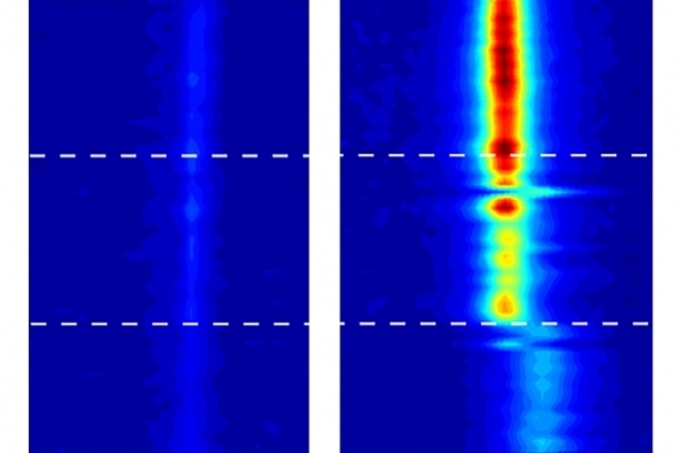Nov 29 2016
 A team at MIT has found an unexpected discovery about water: Inside the tiniest of spaces—in carbon nanotubes whose inner dimensions are not much bigger than a few water molecules—water can freeze solid even at high temperatures that would normally set it boiling. The finding might lead to new applications such as ice-filled wires. Credit: Courtesy of the researchers.
A team at MIT has found an unexpected discovery about water: Inside the tiniest of spaces—in carbon nanotubes whose inner dimensions are not much bigger than a few water molecules—water can freeze solid even at high temperatures that would normally set it boiling. The finding might lead to new applications such as ice-filled wires. Credit: Courtesy of the researchers.
It is a known fact that water at sea level starts boiling at a temperature of 100 °C or 212 °F. Scientists have long observed that the freezing and boiling points of water change slightly when it is confined to very small spaces - usually dropping by about 10 °C.
A group of researchers from the MIT have now observed an entirely unanticipated set of changes: Inside the smallest spaces, such as carbon nanotubes with inner dimensions not much bigger than a few water molecules, water can freeze at high temperatures that it would normally start boiling.
The finding illustrates the way in which even well-known materials can quickly change their behavior when they are confined inside nanoscale structures. The discovery may lead to new applications such as, essentially, ice-filled wires that exploit the distinctive thermal and electrical properties of ice while being stable at room temperature.
The outcomes of the research have been recently reported in a paper, by Michael Strano, the Carbon P. Dubbs Professor in Chemical Engineering at MIT, postdoc Kumar Agrawal, and three others, published in the journal Nature Nanotechnology.
“If you confine a fluid to a nanocavity, you can actually distort its phase behavior,” Strano explains, referring to how and when the substance transforms between solid, liquid, and gas phases.
Although such effects were anticipated, the enormous magnitude of the change and its direction (increasing rather than decreasing in the freezing point) were a complete surprise: In one of the tests conducted by the group, the temperature at which water solidified was 105 °C or even greater.
Note that although the exact temperature is difficult to determine, 105 °C was taken to be the minimum value in this test; the actual temperature could have been somewhere near 151 °C.
The effect is much greater than anyone had anticipated.
Michael Strano, Professor, MIT
It could be observed that the behavior of water altered inside the tiny carbon nanotubes, referring to soda-straw-shaped structures formed entirely of carbon atoms but with a diameter of only a few nanometers, essentially depends on the tubes’ exact diameter. “These are really the smallest pipes you could think of,” Strano stated. During the experiments, reservoirs of water were positioned at each opening of the nanotubes, and both ends of the tubes were left open.
The researchers discovered that even differences of 1.05 and 1.06 nm between the nanotubes made a difference of tens of degrees in the assumed freezing point. Huge differences such as those were totally unanticipated. “All bets are off when you get really small,” Strano stated. “It’s really an unexplored space.”
In previous attempts to understand the behavior of water and other fluids when limited to very small spaces, “there were some simulations that showed really contradictory results,” he explained. One of the reasons is that many teams could not accurately measure the sizes of their carbon nanotubes, not being aware that even very small differences can lead to such different outcomes.
It is astonishing that water even enters into such tiny tubes in the first place.
Carbon nanotubes are thought to be hydrophobic, or water-repelling, so water molecules should have a hard time getting inside. The fact that they do gain entry remains a bit of a mystery.
Michael Strano, Professor, MIT
Strano and his group used exceptionally sensitive imaging systems, employing a technique known as vibrational spectroscopy. This technique allows water movements to be tracked inside the nanotubes, making detailed measurement of its behavior possible for the first time.
The group could detect the presence of water in the tube as well as its phase, Strano says: “We can tell if it’s vapor or liquid, and we can tell if it’s in a stiff phase.”
Although the water certainly goes into a solid phase, the team avoid calling it “ice” as the term suggests a particular type of crystalline structure, which they have not been conclusively able to show to exist in these confined spaces. “It’s not necessarily ice, but it’s an ice-like phase,” Strano explained.
As this solid water does not melt until well above the normal boiling point of water, it must remain perfectly stable under room-temperature circumstances for an unlimited period of time. Strano stated that such a characteristic makes it a potentially applicable material for a wide range of prospective applications.
For instance, it can be used to produce “ice wires,” one of the best known carriers of protons, as water conducts protons close to 10 times more readily than conventional conductive materials. “This gives us very stable water wires, at room temperature,” he says.
The research group also comprised of MIT graduate students Steven Shimizu and Lee Drahushuk, and undergraduate Daniel Kilcoyne. The work was funded by the U.S. Army Research Laboratory and the U.S. Army Research Office through the MIT Institute for Soldier Nanotechnologies, and Shell-MIT Energy Initiative Energy Research Fund.